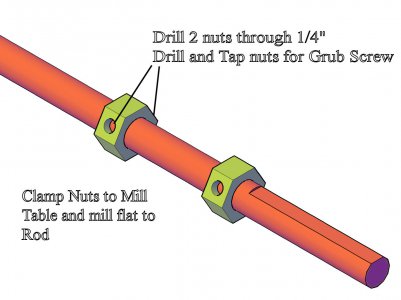I’m a newbie and just finished my first major milling job. Can some of you experts suggest better ways of doing it?
I wanted to mill 3 flats on the end of a long 1/4” dia. drill extender. (To keep it from slipping in my hand drill chuck). But I have no rotary table or any way or measuring the 120° rotation of the shaft accurately. I figured it wasn’t terribly critical and a few degrees off wouldn’t keep the shaft from locking in a 3 jaw drill chuck. I clamped the shaft in my vise, fastened a miniature 6” woodworking clamp to the shaft with the handle pointing up and vertical (parallel to a door frame). For the second and third flats I “eyeballed” the angle of the 6” clamp relative to the door frame with a protractor.
Is there a more accurate way to do this?
I wanted to mill 3 flats on the end of a long 1/4” dia. drill extender. (To keep it from slipping in my hand drill chuck). But I have no rotary table or any way or measuring the 120° rotation of the shaft accurately. I figured it wasn’t terribly critical and a few degrees off wouldn’t keep the shaft from locking in a 3 jaw drill chuck. I clamped the shaft in my vise, fastened a miniature 6” woodworking clamp to the shaft with the handle pointing up and vertical (parallel to a door frame). For the second and third flats I “eyeballed” the angle of the 6” clamp relative to the door frame with a protractor.
Is there a more accurate way to do this?



